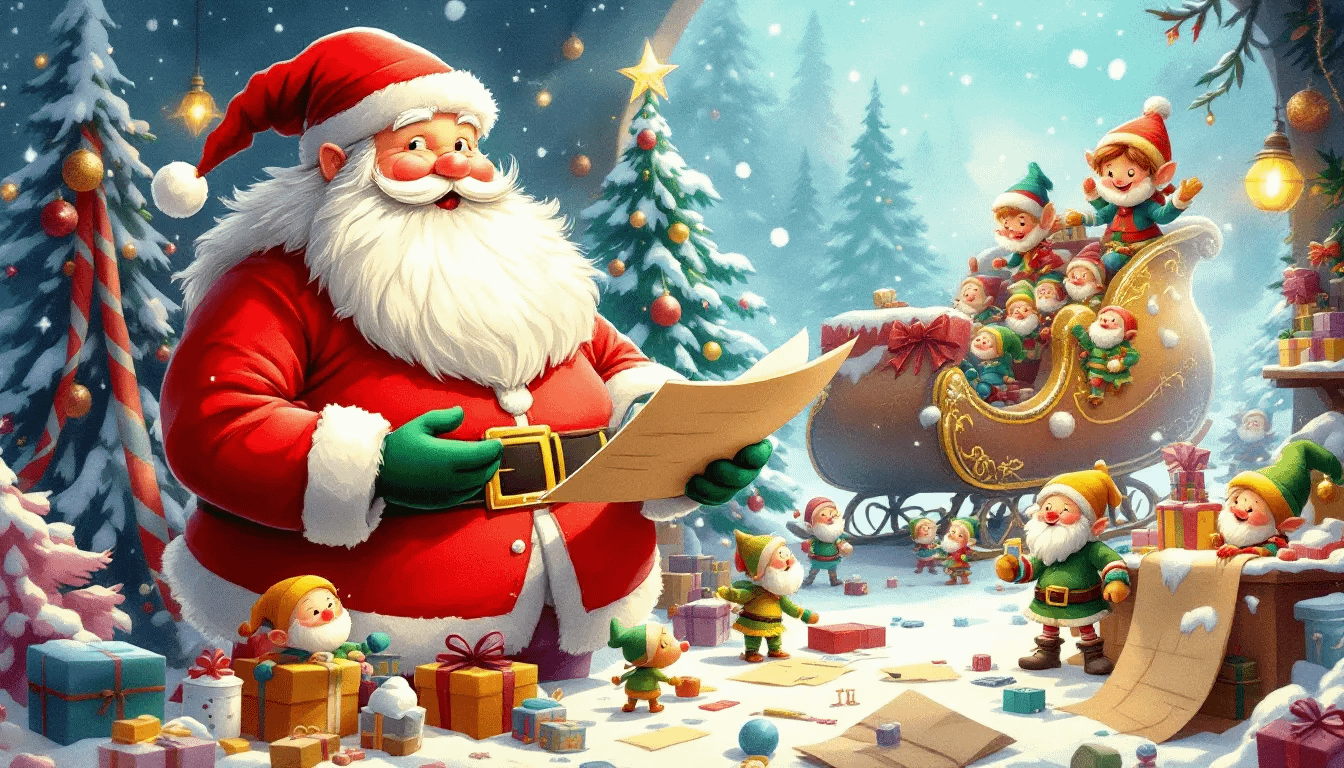In Europe, Santa Claus doesn’t just wear red. This continent celebrates the holiday season with a variety of characters, from the majestic Sinterklaas in the Netherlands to the gift-giving La Befana in Italy. Our guide delves into the diverse and distinctive Santa traditions found across Europe, each bringing its own flavor to the festive tapestry.
Key Takeaways
Santa Claus has various counterparts across Europe, from Sinterklaas in the Netherlands and Father Christmas in the UK to Père Noël in France and Ded Moroz in Russia, each with unique traditions and features.
Northern European countries have their own distinctive Christmas figures such as Finland’s Joulupukki, Norway’s Julenissen, and Sweden’s Jultomten, rooted in ancient folklore and representing cultural diversity.
The mosaic of Santa Claus that we recognize globally today is a blend of multiple European traditions and was popularized through media like Coca-Cola advertising in the 20th century, originating from a combination of figures like Dutch Sinterklaas and Finnish Joulupukki.
European Santa Claus Variations

Indeed, the jolly old man we know as Santa Claus has a host of European cousins, each with their unique traditions and tales. Some of these European counterparts include:
The Dutch Sinterklaas, who served as the basis for the modern-day American Santa Claus
The Nordic folklore figure Jultomten, who delivers Christmas presents in Sweden
The Italian La Befana, a kind old witch who brings gifts to children on Epiphany
The British Father Christmas, who is often depicted as a merry old man in a green robe
The German Christkind, a young girl with angelic features who brings gifts on Christmas Eve
Santa Claus takes on a multitude of fascinating forms across Europe, including at the renowned Santa Claus Village.
The character we adore today has evolved from both dark pagan traditions and the Christian legends of Saint Nicholas, weaving a rich tapestry of tradition that spans centuries and continents, including the celebration of the Christ Child on Saint Nicholas Day and the anticipation of Saint Nicholas Eve.
Sinterklaas (Netherlands)
In the Netherlands, Santa Claus takes the form of Sinterklaas, a figure based on the historical Saint Nicholas, the patron saint of children. Sinterklaas arrives in town on a white horse, adorned with a red bishop’s hat, a jeweled staff, and a big, red book recording the deeds of children. The festival involves delightful treats like pepernoten, speculaas, and chocolate letters, making it a significant celebration in Holland since the middle ages.
One controversial figure that accompanies Sinterklaas is Zwarte Piet, his Moorish apprentice, who traditionally appears in blackface and carries candy and a birch rod to punish naughty children.
Father Christmas (United Kingdom)
In the United Kingdom, the traditional British version of Santa Claus is known as the traditional Father Christmas. Recognized for his hooded green cloak, decorated with a wreath of holly or ivy, and a staff in hand, his origins are intriguingly linked to pagan mythology, representing aspects of winter and nature.
Père Noël (France)
In France, the French Santa Claus, known as Père Noël, is characterized by his long red cloak. However, he’s not alone in his festive duties. Père Noël is often accompanied by Père Fouettard, a not-so-friendly figure who punishes children who have misbehaved by spanking them – a chilling contrast to the jolly old man we all adore.
Ded Moroz and Snegurochka (Russia and Ukraine)
The Slavic wizard, Ded Moroz, or ‘Old Man Frost’, and his granddaughter, Snegurochka, also known as ‘Snow Maiden’, are the traditional Christmas figures in Russia and Ukraine. Ded Moroz, dressed in long blue and white robes, brings gifts to children, traveling across the Slavic region on New Year’s Eve alongside Snegurochka, spreading joy and merriment. In some cultures, Ded Moroz is also referred to as “Grandfather Christmas.”
Northern European Traditions

Continuing our festive journey, we delve into the enchanting realm of Northern European Christmas traditions. Here, we find unique interpretations of Santa Claus, each one steeped in deep-rooted folklore and captivating customs.
From Finland’s Joulupukki to Sweden’s Jultomte and Norway’s Julenissen, each character adds a distinct charm to the holiday season, painting a vibrant picture of cultural diversity.
Joulupukki (Finland)
Santa Claus, known as Joulupukki in Finland, translates to the Yule goat. This unique portrayal of Santa has deep cultural significance in Finland. This character was originally a malevolent spirit linked to the Norse god Odin but has since transformed into a more Santa-like figure, complete with a reindeer-drawn sleigh and a home in the mythological Korvatunturi.
Nowadays, Joulupukki is often accompanied by Joulumuori, or ‘Old Lady Christmas’, adding a familial touch to the holiday tradition.
Julenissen (Norway)
The traditional Christmas beings in Norway, known as Julenissen, have a fascinating history. They were originally perceived as barn devils who acted as spirit guardians over farms. However, these beings have since been transformed into grey-bearded figures, donning grey clothes, and bearing a striking resemblance to Santa Claus.
Jultomten (Sweden)
Jultomten, also known as Tomte, is a traditional Christmas character in Sweden. Despite having unique cultural origins, today’s Jultomten is portrayed similarly to the globally recognized Santa Claus.
On December 24th, Jultomten takes on the task of delivering presents, marking the holiday celebration in a way that is familiar to us all, including the story of baby Jesus and the tradition of the Christmas tree.
Southern European Legends

We now turn our attention to the sunnier climes of Southern Europe, where the spirit of Christmas manifests differently. Here, we find distinctive characters, each with their own folklore and unique ways of celebrating the festive season. From Spain’s Los Reyes Magos to Italy’s La Befana, these legends bring a vibrant twist to the tradition of gift-giving.
Los Reyes Magos (Spain)
The tradition of Los Reyes Magos, or the Three Kings, is deeply rooted in Spain. Symbolizing the gifts given by the Wise Men to Jesus, this tradition sees children receive gifts on January 6th, akin to the tradition of gift-giving during Christmas in other cultures.
The anticipation for the gifts from the Three Kings is celebrated with festive parades and the sharing of a special ring-shaped cake called ‘Roscon de Reyes’.
La Befana (Italy)
La Befana, a good-natured witch who rewards or punishes children based on their behavior, is a traditional figure in Italy. Originating from Italian folklore as early as the 8th century, La Befana flies on a broomstick on the eve of the Epiphany to deliver her gifts through the chimneys of children’s homes.
But beware, if you’ve been naughty, you might just find coal in your stocking!.
The Darker Side of European Christmas Folklore

Next, we explore the shadowy corners of European Christmas folklore, where misbehaving children are threatened with daunting penalties. These tales feature figures like Jólakötturinn, the Yule Cat who prowls Iceland in search of children without new clothes to devour, and Frau Perchta, the witch of the Alps feared for her tradition of rewarding the well-behaved with silver and disfiguring the ill-mannered.
Krampus (Austria, Germany, and Switzerland)
Children in Austria, Germany, and Switzerland are warned to behave well to avoid crossing paths with Krampus, a Christmas demon who disciplines mischievous children during the Christmas season. He carries chains and a bundle of birch branches, symbolizing his role as a disciplinarian, and is known for his punishments, which include leaving sticks in children’s shoes, giving beatings, or even dragging them to hell.
Despite his fearsome reputation, Krampus has recently gained a resurgence in popularity, perhaps due to modern media attention.
Gryla (Iceland)
Gryla, an ogress who preys on misbehaving children, is a figure from Icelandic folklore active during the holiday season. Gryla is notorious for capturing naughty children in her sack and cooking them in her cauldron as punishment. She also has a Yule Cat who targets those without new clothes for Christmas, and a troll husband, Leppalúði, who helps her in capturing children.
Santa Claus: A Global Perspective

Finally, viewing Santa Claus from a global perspective reveals an intriguing mix of influences. The evolution of Santa Claus involves a blend of influences from:
Dutch Sinterklaas
Slavic Ded Moroz
Finnish Joulupukki
and more
The modern image of the modern day Santa Claus, the one we know and love today, was solidified through the 1920s and 1930s advertising by The Coca-Cola Company, particularly by illustrator Haddon Sundblom.
This evolution also includes the transformation from a small, elf-like figure to the well-known red-coated, bearded Santa via Thomas Nast’s Civil War illustrations. Nast popularized the ideas of Santa Claus living at the North Pole, maintaining a workshop, and keeping a list of naughty or nice children. Other influences include Washington Irving’s depiction of St. Nicholas and Clement Moore’s poem ‘A Visit from St. Nicholas’, both of which were seminal in creating the jolly, sleigh-riding image of Santa Claus.
This global mosaic of Santa Claus as we know him today is a product of various European influences, each contributing to the legend’s evolution and worldwide adoption. Each figure, from Sinterklaas to Ded Moroz, has added its unique charm to the festive season, making the holiday a truly universal celebration of joy, love, and generosity.
Summary
To wrap up our festive journey, we’ve explored the many faces of Santa Claus across Europe, delving into a variety of fascinating traditions and legends. From Sinterklaas in the Netherlands to Ded Moroz in Russia, Joulupukki in Finland to the Los Reyes Magos in Spain, each unique character adds a distinctive charm to the Christmas season. Even the darker figures of folklore, like Krampus and Gryla, add a thrilling edge to the holiday tales. The evolution of Santa Claus is a testament to the rich tapestry of cultures and traditions that make up our world, reminding us that the spirit of Christmas is universal. So, no matter how you celebrate, may your Christmas be filled with joy, love, and a touch of magic!
Frequently Asked Questions
Who is Sinterklaas?
Sinterklaas is the Dutch version of Santa Claus, based on the historical figure of Saint Nicholas, the patron saint of children, who arrives on a white horse wearing a bishop’s hat and brings gifts on December 5th and 6th.
What is the difference between Father Christmas and Santa Claus?
Father Christmas is known for wearing a green cloak and representing winter and nature, while Santa Claus is more commonly associated with the red suit and jolly persona. So, they have different origins and visual characteristics.
Who are Ded Moroz and Snegurochka?
Ded Moroz is a Slavic wizard who brings gifts to children in Russia and Ukraine, while Snegurochka, also known as ‘Snow Maiden’, is his granddaughter and companion in the festive gift-giving tradition. They are part of the holiday traditions in these countries.
What is the tradition of Los Reyes Magos in Spain?
In Spain, the tradition of Los Reyes Magos, or the Three Kings, involves children receiving gifts from the Three Kings on January 6th, as a representation of the gifts given to Jesus by the Wise Men. It’s similar to the tradition of gift-giving during Christmas in other cultures.
Who is Krampus?
Krampus is a half-goat, half-demon figure who disciplines mischievous children during the Christmas season. He is a part of the folklore in Austria, Germany, and Switzerland.


